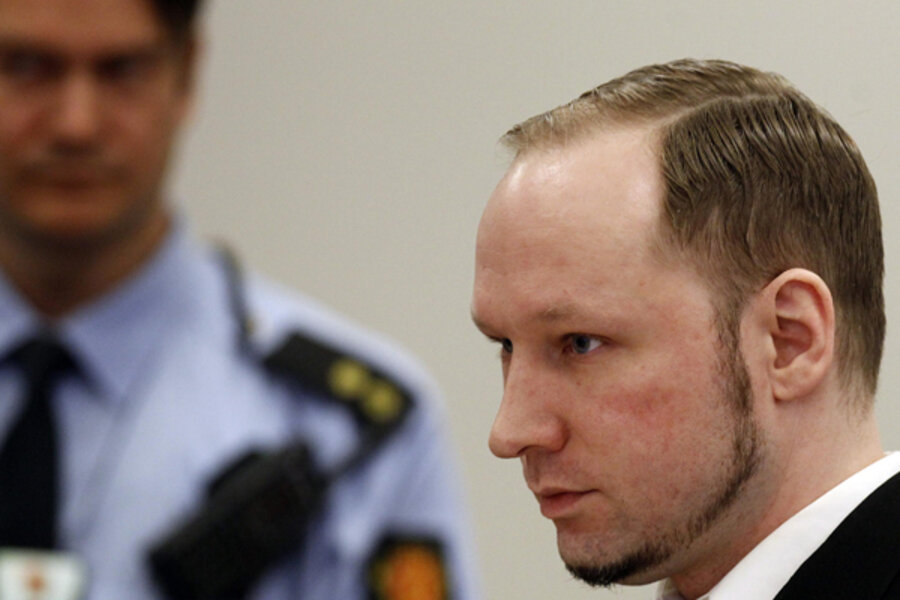Norwegian murderer Breivik had planned even more sweeping attack
Loading...
| Oslo
Norwegian mass murderer Anders Behring Breivik was pressed by prosecutors today to shed light on the five years’ leading up to last summer’s twin terror attacks in an attempt to pinpoint the start of his violent planning phase.
Brevik admitted during his third day of testimony that he first started contemplating taking violent action when he was 18 or 19, before he came in contact with anti-Muslim group Knights Templar in London in 2002, and that the Labor party youth camp at Utøya island was not his original target.
He told prosecutors he first considered attacking Muslims, but changed his targets to “political elites” he considered responsible for Muslim immigration in 2006, after the Benjamin Hermansen case, in which neo-Nazis killed a young Norwegian-Ghanaian boy in Oslo in 2001. “It’s not the fault of Muslims that they were invited [to immigrate],” said Breivik. “They are not to blame.”
Coincidentally, the convicted murderer in that case was defended by Breivik’s current defense attorney, Geir Lippestad.
Breivik has blamed the Labor party for promoting multiculturalism and the Islamic colonization of Europe as the basis for his July 2011 bomb attack on government buildings in Oslo and a shooting rampage at the Labor party summer youth camp at the island of Utøya.
Breivik said that he originally considered deploying car bombs against three separate targets – the main Oslo government building, the Norwegian Royal Castle, and Labor party headquarters – but only ended up attacking the first because he could not produce enough explosives and risked killing too many “innocents.” He had also considered media targets, including Norwegian broadcaster NRK headquarters, newspaper Aftenposten, and the journalist conference SKUP.
“Norwegian press bears the largest part of the responsibility, maybe even more so than the Labor party, for the situation we are in now,” said Breivik.
He said his original plan was to arrive at Utøya earlier that day to decapitate former Labor prime minister Gro Harlem Brundtland with a bayonette on his rifle and film it, execute Labor party youth leader Eskil Pedersen, and kill all on the island that day by shooting and scaring the Labor youth to swim and drown.
The prosecutors attempted to portray Breivik as a cash-strapped and video game-obsessed young man living with his mother, during which time he started writing his manifesto “2083: A European Declaration of Independence” and planning his attack.
Svein Holden, Oslo public prosecutor, presented evidence detailing about 16 hours per day of game time on World of Warcraft in 2006 and 2007 and 500 hours from November 2010 to February 2011, as well as an average of 10 hours per day for 16 months on the war simulation game Call of Duty beginning in January 2010.
But Breivik said it was his decision to take a “sabbatical” from work and play World of Warcraft for one year in anticipation of his “suicide action” so that he would “have no regrets.”
“It’s mere entertainment,” said Breivik. “It has nothing to do with July 22. Some like to sail, some like to play golf. Some like to play World of Warcraft.”
He also defended prosecution’s questions regarding his naming of his rifle “Gungnir” after Norse mythological god Odin’s magic spear and his Glock “Mjolner,” the name of Norse god Thor’s hammer.
“The way you [Holden] try to describe it is as bizarre and insane, but it is a great [Norse] tradition,” said Breivik, adding that many warriors in the past had given names to their weapons.
The case against Breivik hinges on determining whether he is sane after two psychiatric reports came to opposite conclusions, the first saying he was paranoid schizophrenic and the second finding him not psychotic.
Breivik claims he is sane and wants to be considered such so that his ideology “would stand stronger." Based on the initial conclusion of paranoid schizophrenia, the prosecution is seeking compulsory mental care, although there is a possibility of choosing later in the trial to seek a criminal punishment of up to 21 years.
Breivik has pleaded not guilty, saying his actions were a “preventive attack” against the ethnic cleansing of indigenous Norwegians by Muslims.







